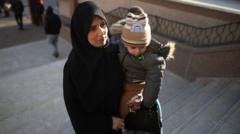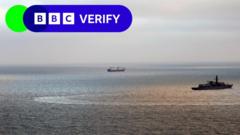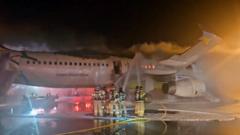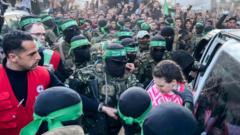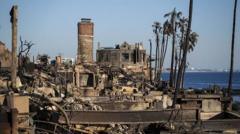Russian naval activity at the Tartous base in Syria has sparked speculation regarding an ongoing military withdrawal as the regime shifts in the region.
Russian Naval Activity in Syria Signals Potential Military Withdrawal
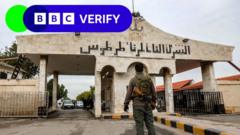
Russian Naval Activity in Syria Signals Potential Military Withdrawal
Recent docking of Russian vessels at Tartous raises questions about military presence.
The two Russian military-linked vessels, the Sparta and Sparta II, have docked at the port of Tartous, following a lengthy absence of naval activity that experts now believe signals the beginning of a military withdrawal from Syria. This development comes alongside reports indicating that Russia's lease on the Tartous facility may have been cancelled.
Eyewitness images revealed that large quantities of military hardware have been recently transported to the port, showcasing a considerable increase in Russian military presence at a time when analysts had predicted a reduction following changes in the Syrian regime.
The docking of the Sparta and Sparta II has led to speculation that Russia is reorganizing its military strategies in light of potentially decreased influence in the region after supporting the Assad regime throughout its protracted civil conflict. The Kremlin has historically utilized the Tartous base for naval operations, including refueling and repairing vessels stationed in the Mediterranean.
Reports suggest that these ships were initially prohibited from docking as negotiations surrounding future Russian presence at Tartous progressed. The vessels drifted in the Mediterranean for weeks before finally arriving at the port, where they turned off their transponders post-arrival.
Moreover, recent satellite imagery acquired from the EU’s Sentinel radar satellites unveiled the vessels occupying a military section of the port, amid visible preparations indicating an evacuation might be underway. Analysts suggest that other Russian ships, such as the Ivan Gren and Alexander Otrakovsky, could be involved in similar operations.
Experts are analyzing the broader implications of the potential evacuation, with the understanding that much more military equipment has been brought into Tartous over the years than can be shipped out rapidly.
Compounding the situation is ongoing activity at the Hmeimim airbase, where reports indicate continued loading of military assets onto Russian aircraft—some of which have been reported to be redeploying to airbases in Libya. The relocation strategy aligns with Moscow’s support for the Tobruk-based warlord Khalifa Haftar, showcasing a shift in Russian military focus toward its operations in North Africa.
This situation underscores Moscow's evolving military strategy following the complexities of the Syrian conflict, indicating that while traditional naval activities may be waning, Russian military commitments to other regions are escalating.
Eyewitness images revealed that large quantities of military hardware have been recently transported to the port, showcasing a considerable increase in Russian military presence at a time when analysts had predicted a reduction following changes in the Syrian regime.
The docking of the Sparta and Sparta II has led to speculation that Russia is reorganizing its military strategies in light of potentially decreased influence in the region after supporting the Assad regime throughout its protracted civil conflict. The Kremlin has historically utilized the Tartous base for naval operations, including refueling and repairing vessels stationed in the Mediterranean.
Reports suggest that these ships were initially prohibited from docking as negotiations surrounding future Russian presence at Tartous progressed. The vessels drifted in the Mediterranean for weeks before finally arriving at the port, where they turned off their transponders post-arrival.
Moreover, recent satellite imagery acquired from the EU’s Sentinel radar satellites unveiled the vessels occupying a military section of the port, amid visible preparations indicating an evacuation might be underway. Analysts suggest that other Russian ships, such as the Ivan Gren and Alexander Otrakovsky, could be involved in similar operations.
Experts are analyzing the broader implications of the potential evacuation, with the understanding that much more military equipment has been brought into Tartous over the years than can be shipped out rapidly.
Compounding the situation is ongoing activity at the Hmeimim airbase, where reports indicate continued loading of military assets onto Russian aircraft—some of which have been reported to be redeploying to airbases in Libya. The relocation strategy aligns with Moscow’s support for the Tobruk-based warlord Khalifa Haftar, showcasing a shift in Russian military focus toward its operations in North Africa.
This situation underscores Moscow's evolving military strategy following the complexities of the Syrian conflict, indicating that while traditional naval activities may be waning, Russian military commitments to other regions are escalating.

